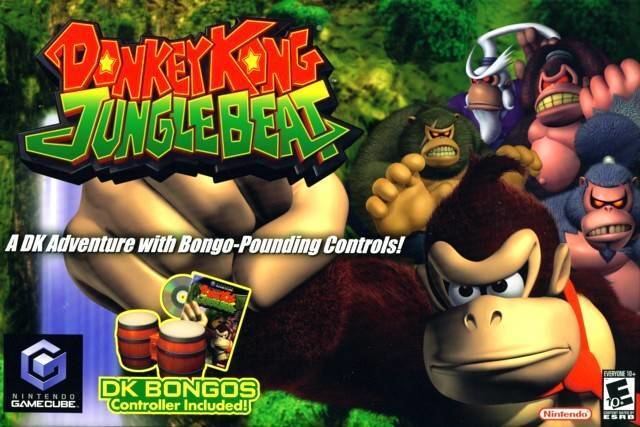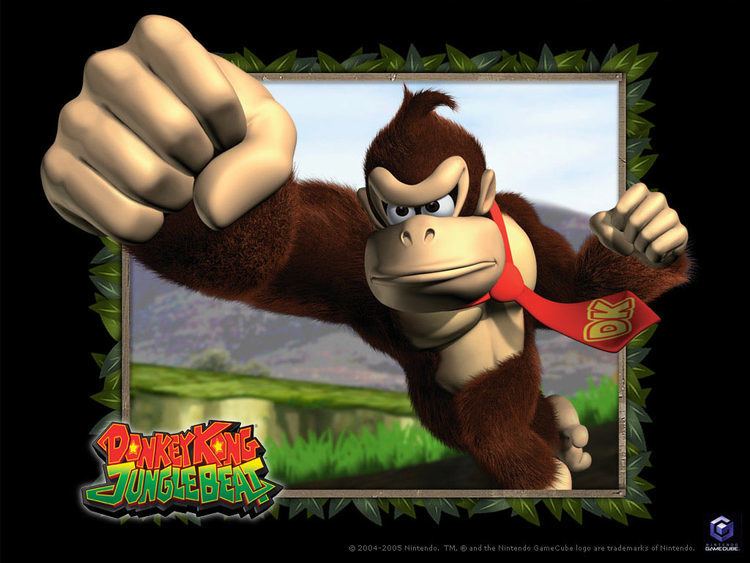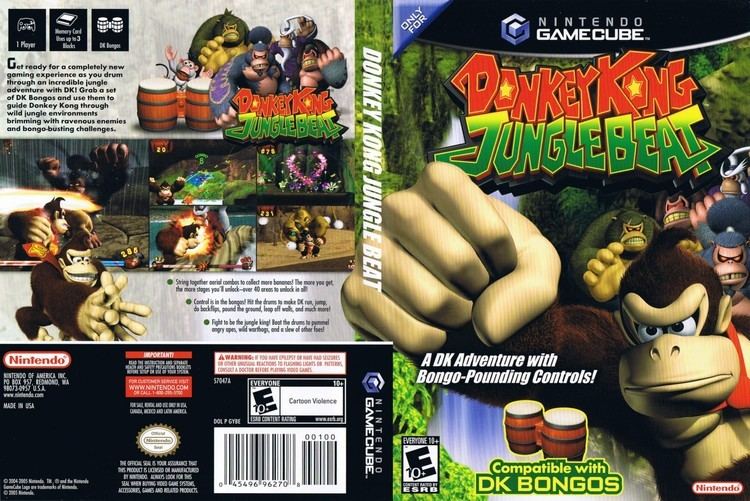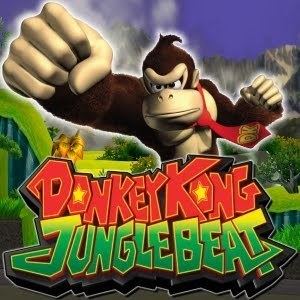9 /10 1 Votes9
8.8/10 IGN Producer(s) Takao Shimizu Mode(s) Single-player | 4.5/5 Emuparadise 4.5/5 eBay Initial release date 16 December 2004 Genre Platform game | |||||||||||||||||||||||||||||||||
 | ||||||||||||||||||||||||||||||||||
Release date(s) GameCubeJP: December 16, 2004EU: February 4, 2005NA: March 14, 2005AU: March 17, 2005WiiJP: December 11, 2008NA: May 4, 2009EU: June 5, 2009AU: June 18, 2009 Similar Donkey Kong games, Shigeru Miyamoto games, Platform games | ||||||||||||||||||||||||||||||||||
Donkey kong jungle beat all bosses no damage
Donkey Kong Jungle Beat (ドンキーコングジャングルビート, Donkī Kongu Janguru Bīto) is a platforming video game developed and published by Nintendo for the GameCube. It was released in Japan in December 2004, in Europe in February 2005, and in North America and Australia in March 2005. In 2008 and 2009, the game was re-released in the New Play Control! series of revamped GameCube titles. Donkey Kong Jungle Beat features the ape Donkey Kong and is played with the DK Bongos.
Contents
- Donkey kong jungle beat all bosses no damage
- Cgr undertow donkey kong jungle beat for nintendo gamecube video game review
- Gameplay
- Development and release
- Reception
- Impact and legacy
- References

The Wii version of Donkey Kong Jungle Beat is somewhat changed from the original GameCube version, including new levels, modifications of old levels, and traditional controls that have the player use the analog stick to move and the A button to jump, unlike the GameCube version which required the player to beat the bongos to do both. Takashi Nagasako, who previously did the voice of Ganondorf in The Legend of Zelda series, does the voice of Donkey Kong and has continued the role in the years that have followed.

Cgr undertow donkey kong jungle beat for nintendo gamecube video game review
Gameplay

Gameplay involves combat, jumping, and counterattacking. While the traditional GameCube controllers are compatible, Donkey Kong Jungle Beat uses a pair of bongo drums to control Donkey Kong's (DK) actions. Hitting the left drum causes DK to move left, while hitting the right drum causes him to move right. Hitting both drums at the same time causes DK to jump. Clapping one's hands or hitting the sides of the drums also causes DK to clap, which has various consequences depending on the situation.

This is a unique game in the nature of play; it is a platformer where the goal is not simply to get to the end of the level. The goal is to get as many points, or "beats", as possible. Beats are obtained by grabbing bananas during gameplay, and lost by getting hurt or touching the ground. The player can obtain additional beats by performing combos while grabbing the bananas. For example, three combo moves will earn four beats for each banana collected. Combos can go as high as 30, meaning that 31 beats can be earned from a single banana. Time records can also be earned for stages and for racing sections of stages.

DK can perform moves such as backflips, the ground-pound, vine swinging, corner hopping, and wall jumping. He can also use other objects and animals in the game to add to the combo score. When performing "combo-moves", a counter is started, rising with each successive combo move acquired before landing. The combo counter is lost when DK is hurt or falls, and all beats are lost. If DK's beat count reaches zero, he loses and will have to restart the level. In the Wii version of the game, hearts represent DK's health instead of the beats, and there are extra lives and checkpoints throughout the level.
Clapping or making any other noise that the microphone in the Bongos picks up makes DK clap his hands. The hand clap produces two rings, a small red one and a giant green one. Enemies in the small red ring are usually defeated, and those in the larger green ring are usually stunned. Stunned enemies can then be jumped on and defeated by hitting the bongos repeatedly. Any bananas in the small red ring are grabbed in a chain, each incremented in value relative to the last (e.g., if three combo moves are done when DK clap-grabs 5 bananas, the bananas are worth 4, 5, 6, 7 and 8).
The level system consists of several "kingdoms". Each kingdom contains three platforming levels. The first two sometimes contain racing and puzzle elements, which the final "boss" stage contains a fight against a large enemy. The beats obtained in the previous two levels are used as health for the fight against the boss, and the aim is to beat the boss without taking too many hits, lowering your beat count. There are many different types of bosses, each requiring different tactics to beat. For example, fights with other gorillas are fought in a Punch-Out!!-style bout, while battles against elephants require throwing back bombs that they fire. The gameplay relies on rhythm elements, such as clapping at the right time to get all of the bananas in an area, or incapacitate a boss.
Between each level, there is a short minigame where the player must tap the bongos as fast as they can to earn extra bananas. The exception to this are levels in which DK rides a wildebeest, in which case the minigame is to either fly the farthest from a jump, or stay on high ground long enough to collect many bananas without touching the ground.
At the end of the kingdom, the total sum of beats (after deducting any damage taken during the boss fight) is tallied up. Completing a kingdom earns a crest, while additional crests are earned by achieving certain amounts of beats. Crests are required to play new kingdoms, which is determined by the number shown. Clearing all the kingdoms in a section unlocks the next set of kingdoms. Players can revisit earlier levels to try to earn more beats, thus earning more crests.
Development and release
Shigeru Miyamoto told Takao Shimizu and Yoshiaki Koizumi that they should make a Donkey Kong game. Development began in July 2003. Soon, Miyamoto directed the two developers to a meeting featuring the Bongo controller, which at the time was only compatible with Donkey Konga. They were shown how the controller worked and took a pair of the bongos with them. Most of Koizumi's earlier work had focused on character and camera controls, so he started to think of ways the bongo peripheral could simplify the platform game's control scheme.
Reception
Donkey Kong Jungle Beat received "generally favorable" reviews across both its releases. Most reviewers considered it unique and fun to play but rather short given the retail price. It was praised for its wide appeal; possessing both a simplicity targeted at new gamers, and a complex, skill-oriented combo system to attract more hardcore gamers. IGN praised the GameCube version's graphics, saying, "DK's fur makes StarFox Adventures' models look primitive". Criticisms include the game's short length, despite the replayability offered by the score system in levels. There were also complaints of repetitive boss fights, as the same four bosses are used several times throughout the game with limited features to distinguish them. One of the primary criticisms, however, was the lack of past characters and elements from Rare's DKC games. However, despite these criticisms it was rated the 95th best game made on a Nintendo System in Nintendo Power's Top 200 Games list.
Non video-game publications also praised the GameCube version. The New York Times gave it a favorable review and called it "wildly entertaining". The Sydney Morning Herald gave it four stars out of five and called it "a charming romp through dazzling jungle environments via glistening ice chambers, volcanic caverns and aquatic wonderlands. But sadly, many players will complete Jungle Beat in just a few hours." Detroit Free Press gave it three stars out of four and stated that "the bongos are, indeed, special. They mean the difference between a predictable game and one that marches to a different drummer." Common Sense Media gave the Wii version four stars out of five and stated that "The bottom line is that it’s fun but brief. Even with its relatively low price tag, the new Jungle Beat might make a better rental than purchase."
Impact and legacy
Many gameplay elements from Donkey Kong Jungle Beat were reused in Super Mario Galaxy, which was made by the same development team. The helper monkeys were originally going to appear in the game as enemies, but were later removed. These gameplay elements would also be used in its sequel.
In Super Smash Bros. Brawl, a stage based on Donkey Kong Jungle Beat appears in the form of Rumble Falls. It is a stage that scrolls upward, similar to Melee's Icicle Mountain stage. One of the music pieces that can be played on the stage is the BGM of the level "Battle for Storm Hill." Additionally, Donkey Kong's "Final Smash" move involves him repetitively hitting bongo drums and clapping for a brief time, similar to how Jungle Beat is played, and grows in range and damage if the player pressed buttons in sync with the beat. Several stickers and trophies based on the game can be collected.
Donkey Kong Jungle Beat was reformatted for the New Play Control! program, a brand of Nintendo GameCube video game remakes for the Wii. It was released on December 11, 2008, in Japan and later in North America and Europe on May 4, 2009, and June 5, 2009, respectively. It uses a combination of the Wii Remote and the Nunchuk instead of the DK Bongos (the DK Bongos are not compatible with the Wii version), using both traditional controls and motion controls. As well different modes in the remake, there are a few changes to the gameplay. Health is no longer determined by the amount of beats, but instead uses a more traditional heart and life system. Clap attacks are also directional as opposed to all around.
